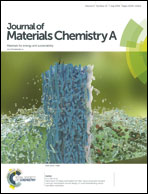Quaternary two dimensional Zn–Ag–In–S nanosheets for highly efficient photocatalytic hydrogen generation†
Abstract
Hydrogen generation based on photocatalytic water splitting is a promising strategy for renewable energy production. Significant efforts have been made to improve the photocatalytic efficiency. However, the light harvesting ability of photocatalytic systems in the visible region still needs to be significantly improved to enable them to be a competitive technology for hydrogen generation. Herein, for the first time, we synthesized 2D Zn–Ag–In–S (ZAIS) nanosheets with strong absorption in the visible region and applied them for photocatalytic hydrogen generation. The exploration of oxygen passivation (O-ZAIS) reduced the defect concentration and nonradiative decay. The hydrogen generation rate is up to 25.2 mmol g−1 h−1, which is 14.7 times higher than that of pristine ZAIS nanosheets. Furthermore, by introducing 2D Co3O4 as the co-catalyst, carrier separation is accelerated, giving rise to a hydrogen generation efficiency of 43.6 mmol g−1 h−1. To the best of our knowledge, this is the highest efficiency reported among all kinds of 2D photocatalysts.



 Please wait while we load your content...
Please wait while we load your content...